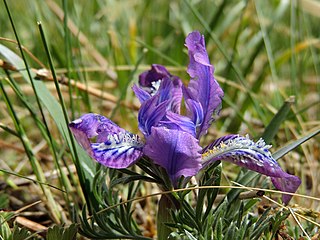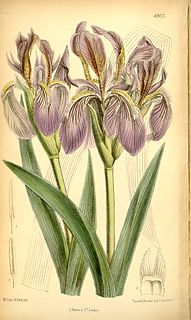
Tulipa turkestanica, the Turkestan tulip, is a species of tulip native to central Asia. It was first described by Eduard August von Regel in 1873 as a variety of T. sylvestris, then elevated to full species status two years later.

Tulips (Tulipa) are a genus of spring-blooming perennial herbaceous bulbiferous geophytes. The flowers are usually large, showy and brightly coloured, generally red, pink, yellow, or white. They often have a different coloured blotch at the base of the tepals, internally. Because of a degree of variability within the populations, and a long history of cultivation, classification has been complex and controversial. The tulip is a member of the lily family, Liliaceae, along with 14 other genera, where it is most closely related to Amana, Erythronium and Gagea in the tribe Lilieae.

Oxalis glabra is a member of the wood-sorrel family, Oxalidaceae. It is only one of the 800 total species belonging to this family. The plant is commonly known as finger-leaf due to its trifoliate leaf structure. This trifoliate structure can be seen in variations throughout all members of the genus Oxalis. However, the particularly narrow leaflets of the glabra plant look more like fingers rather than a common clover. The plant is native to South Africa and can be found carpeting the ground of woodlands and bushlands.

Tulipa armena is a species of flowering plant in the Liliaceae family. It is referred to by the common name Armenian tulip, and is native to the historical Armenian Highlands as the name implies; current regions of Armenia, modern day Turkey, Iran, South Caucasus, and Azerbaijan.

Tulipa saxatilis is a Greek and Turkish species of plant in the genus Tulipa of the family Liliaceae.
Iris ventricosa is a beardless iris in the genus Iris, in the subgenus Limniris and in the series Tenuifoliae of the genus. It is a rhizomatous herbaceous perennial, from Asia and the Russian Federation, to Mongolia and China. It has grey-green leaves, short flowers stems and 1–2 pale violet or pale blue flowers.
Iris ludwigii, with the common name Ludwig iris, is a species in the genus Iris. It is also in the subgenus Iris subg. Limniris and in the series Spuriae. It is a rhizomatous perennial plant with violet-blue flowers. It is native to the Altai Mountains in Central Asia, where Russia, China, Mongolia, and Kazakhstan meet. It is cultivated as an ornamental plant in temperate regions.

Tulipa sylvestris, the wild tulip or woodland tulip, is a Eurasian and North African species of wild tulip, a plant in the lily family. Its native range extends from Portugal and Morocco to western China, covering most of the Mediterranean and Black Sea Basins, and Central Asia. The species is also cultivated as an ornamental and naturalized in central and northern Europe as well as a few scattered locations in North America. It was first recorded as being naturalised in Britain in the late 17th century.
Iris ivanovae is a plant species in the genus Iris, it is also in the subgenus Iris and in the section Pseudoregelia. It is a rhizomatous perennial, from eastern Russia, China, and Mongolia.

Iris tigridia is a plant species in the genus Iris, it is also in the subgenus Iris and in the section Pseudoregelia. It is a rhizomatous perennial, from Kazakhstan, Russia, Mongolia and China. It has dark green or greyish green, grass-like leaves, a short slender stem and a single flowers that are either violet, dark blue, blue-purple, dark purple, mauve, lilac, lavender, or light purple. It is cultivated as an ornamental plant in temperate regions.

Iris scariosa is a plant species in the genus Iris, it is also in the subgenus Iris. It is a rhizomatous perennial, from the mountainsides of Russia, Kazakhstan, Mongolia and China. It has sword-like, or sickle shaped, blue green or grey-green leaves, a short flowering stem, 3 or 4 membranous or semi-transparent flower bud leaves, 2 violet, reddish violet, lilac, blue-purple, or blue flowers in late spring, with yellow or white beards. It is cultivated as an ornamental plant in temperate regions. It was merged with another similar iris in the region, and Iris glaucescens became a synonym of Iris scariosa, before being divided into two separate species again. Although some sources still call it the main species, despite a slight colour difference.
Iris purpureobractea is a plant species in the genus Iris, it is also in the subgenus Iris. It is a rhizomatous perennial, from the cliffs and forest glades on the mountains of Turkey. It has straight or falcate shaped leaves, stem with several branches, the stem has purple spathes, it has up to 8 fragrant flowers, in various colours between yellow or blue. It is cultivated as an ornamental plant in temperate regions.

Tulipa hungarica, the Danube tulip, Banat tulip or Rhodope tulip, is a species of flowering plant in the family Liliaceae. It is also in the subgenus Tulipa. It is found on the rocky mountainsides of Bulgaria, Romania, Hungary and Slovenia, especially along the gorges of the river Danube. It has small bright yellow flowers in spring and blue-grey leaves.
Tulipa alberti, is a species of flowering plant in the family Liliaceae. It has long reddish, orange or pink flowers. It comes from the mountains of Central Asia.

Tulipa altaica is a species of tulip found in Russia, Kazakhstan, and China.

Tulipa montana is a species of tulip native to the mountains of Iran and Turkmenistan. With its deep red petals it has been proposed as a candidate for the Biblical Rose of Sharon, whose identity is unknown.

Tulipa biflora, the two-flowered tulip, is a species of tulip, native to the former Yugoslavia, Crimea, Anatolia, the Caucasus, southern Russia, Egypt, the Middle East, Central Asia, Iran, Pakistan, Afghanistan and Xinjiang in China. It has many synonyms, including Tulipa polychroma.

Tulipa fosteriana is a species of tulip, native to the Pamir Mountains and nearby areas of Afghanistan, Kyrgyzstan, Tajikistan and Uzbekistan.

Tulipa praestans is a species of tulip native to the mountains of Tadzhikistan. Many well known cultivars have been formed from the original plant.

Nymphaea tetragona is a species of flowering plant commonly called pigmy waterlily and small white water lily, belonging to the family Nymphaeaceae. In North America and Europe it native range is restricted to the boreal regions above 50° N latitude.















